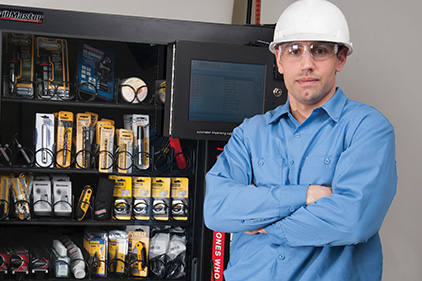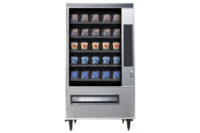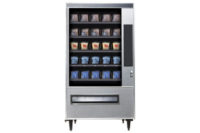Ensure access, reduce costs, increase compliance
Managing PPE through vending machines helps organizations maintain a clean and safe work environment to help reduce injuries and mitigate safety risks. Appropriate PPE, whether it is eye, hearing, respiratory, hand, body or foot protection is critical to almost every safety program. Vending machines make this PPE readily accessible to employees by locating the machine at point-of-use. An employee is more likely to wear gloves during the job if the walk is only three steps to get them, as opposed to 30 steps. The convenience of accessing PPE close to where the work is done increases the likelihood of employee compliance.
In addition to promoting safer behaviors among employees, keeping PPE in readily accessible vending machines can help organizations avoid OSHA violations and costs associated with incidents, including workers’ compensation and lost productivity from downtime and delays. Vending machines allow for controlled access and can be programmed so employees take only the appropriate PPE and other tools for an assigned task. Vending machines also provide employers with PPE usage data that helps manage a safety program and prevent costs. For example, understanding which employees took what PPE and at what time can help drive safe behaviors and compliance among employees to prevent incidents in the first place. Understanding total usage can help organizations avoid overstocking or under-stocking PPE, both of which can be costly in terms of product, productivity and compliance.
Data makes a difference in truly understanding the effectiveness of a safety program and allows organizations to constantly identify new opportunities to improve it. Plus, data from an inventory program managing safety supplies can provide documentation during an OSHA audit or incident inspection.
Not always the best solution
Vending is a tool for managing PPE and other inventory critical to a job; it’s used often and in large volume; and it can be relatively costly to an organization. The most popular PPE items to manage through vending are gloves, safety glasses, hearing protection, and disposable and chemical-resistant clothing. That said, most safety programs demand safety supplies in addition to PPE, and while they can all benefit from cost-savings through inventory management, vending is not always the best solution. The following safety categories are often managed by scanning a barcode to track usage or through a locker-style machine. This is most appropriate when employees need to check in and check out expensive safety equipment such as heat insulated tools.
- First Aid – It is crucial that first aid items are immediately available in the event of a medical emergency. Even when not used regularly, supplies such as first aid kits, spill kits, gloves, gowns, respirators and eyewash bottles must be replenished. Inventory management programs can help make sure your organization is always ready for an emergency by replenishing first aid items when necessary.
- Slips, Trips & Falls – Manufacturing facilities can contain any number of hazards, including open floor and wall openings, ladders and scaffolding, and wet or uneven floor surfaces. Fall protection is important to preventing incidents, and inventory programs can ensure it is always readily accessible.
- Lockout / Tagout (LOTO) – Every manufacturer keeps lockout devices to prevent accidental or unauthorized access to machinery and utilities. OSHA closely monitors LOTO because there is great risk to employees if not managed properly. To stay on top of regulations, organizations must maintain a supply of LOTO equipment for plugs, circuit breakers, switches, and valves, and the accompanying signage — all can be managed through a barcode inventory program.
- Electrical Safety – Most electrical safety accidents result from unsafe equipment or installation, environment or work practices. Preventing and responding to these issues come from practices and having the right safety products in place. Ensuring items such as arc flash gear, testing equipment, signage, heat insulated tools and barricades are in stock is important to managing electrical safety.
Right products, right places, right times
Mitigating safety risks requires having the right products, used properly, in the right places, at the right times. But as critical as safety is, most companies do not have dedicated safety personnel to manage safety inventory, and even if they do, it is likely to be just one of a number of responsibilities. Vending and other inventory management programs help organizations manage their PPE and safety inventory to reduce or avoid costs and help ensure access to critical supplies to keep employees safe on the job.





